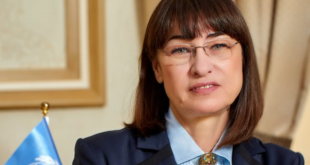Outlining how desalination can help stave off Egypt’s looming water crisis.
Beatrice Maser and Heike Harmgart*
For millennia and in most years the Nile has provided enough water to support the people who call its banks their home. But even the world’s longest river has its limits, and they are quickly approaching.
Egypt’s fast-growing population, expected to hit 160 million by 2050, a 50 per cent increase over today, means that the country will soon need to look beyond the Nile for potable water. The question is: where will that water come from?
One possible answer being explored by the government of Egypt in partnership with our teams at the International Finance Corporation (IFC) and the European Bank for Reconstruction and Development (EBRD) is desalination.
By extracting the salt from the virtually limitless supply of seawater off its coasts, Egypt could lessen the pressure on the Nile and help ward off what some experts call a looming water crisis.
Egypt already has a modest desalination programme. But to fill 160 million glasses with water the country will need to massively scale up the industry, a feat that those of us in the development finance industry firmly believe could be eased with the active participation of the private sector.
Thanks to their innovation, management expertise, and financial muscle, private desalination companies have the potential to transform the industry, turning Egypt into a desalination powerhouse.
This is a model which we already see working today. In 2019, Egypt unveiled its flagship Benban Solar Park, the world’s largest solar installation. Today, the park is lowering the price of energy, strengthening Egypt’s energy mix, and adding more local resources. It will help to avoid millions of tons of greenhouse-gas emissions. This is a win for Egypt’s burgeoning renewable energy industry.
For this reason, we were heartened to see the Egyptian government launch a programme to build 47 desalination plants last year, including four initial facilities which will be constructed through public-private partnerships (PPPs).
There are two main ways to pry salt from water. In thermal desalination, seawater is boiled, and the vapour is condensed, leaving behind water which is free of most salts. The other method, known as reverse osmosis, passes the seawater through a membrane, weeding out the salt.
Both techniques are costly and energy-intensive, which is why large-scale desalination has largely been restricted to wealthy, energy-rich countries, including those in the Gulf.
Desalination can be cheaper than transporting water over huge distances. But in many communities, the water from desalination plants will likely be more expensive than that from the Nile. That is why public-private partnerships are key.
PPPs will foster competition and breed efficiencies, over time helping to lower the price of desalinated water for ordinary Egyptians. They will also relieve the fiscal pressure on the government, allowing it to devote funding to other essential sectors, like healthcare and education.
Over the past six years, Egypt has increased its desalination capacity 10-fold to 800,000 cubic metres of water per day. The four new plants alone, which are to be built in Al-Hamam, Koseir, Marsa Alam and Safaga, will pump out up to 390,000 additional cubic metres of potable water daily.
At the IFC and EBRD, we are proud to say that we will be advising the government of Egypt to structure and tender the public-private partnerships for the first four desalination plants, which can serve as pilots before rolling out a broader programme. Our experience in other countries has shown that well-prepared projects awarded through competition result in the lowest prices and best services.
However, for Egypt’s desalination programme to be a success it needs more than just the participation of private companies. The country will need to upgrade many of its municipal water systems; right now, too much water is lost through leaky pipes.
Moreover, because desalination plants are energy-intensive, the country would be well-served to link them with renewable energy facilities. Given Egypt’s abundance of sunshine and strong winds, that would be a cheaper and more eco-friendly approach than relying on electricity generated from fossil fuels.
Finally, the country should consider reforming its water tariffs, bringing them closer in line with costs.
The IFC and EBRD are committed to supporting the government to address these reforms and help transform the industry.
Egypt is not the only country facing a water crisis. Half the world experiences water scarcity at some point in an average year, and one in four major cities is water stressed. But Egypt remains especially vulnerable: 95 per cent of the country’s water comes from the Nile, and virtually all of that originates from outside Egypt’s borders.
There is also the wildcard that is climate change. We don’t yet know how planetary warming will affect the rains that supply the Nile. But the United Nations Development Programme (UNDP) warns that any reduction in water will have “drastic impacts.”
Desalination alone is not a panacea for Egypt’s looming water crisis. The country will still need to reuse more wastewater, better manage the industrial demand for water, and make irrigation, which in many places still involves flooding fields, far more efficient.
But if done through well-structured PPPs, desalination can be a hedge against climate change, spur private investment in the country, and help lay the foundations for a more sustainable future.
*Beatrice Maser is director for the Middle East and North Africa at the International Finance Corporation (IFC).
*Heike Harmgart is managing director for the Southern and Eastern Mediterranean at the European Bank for Reconstruction and Development (EBRD).
From: Ahram Online






